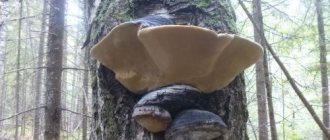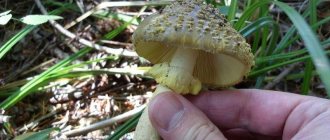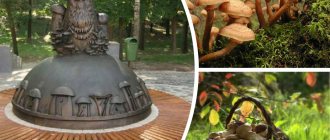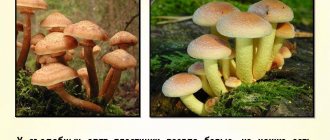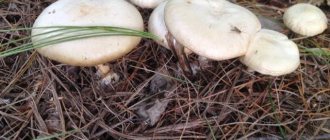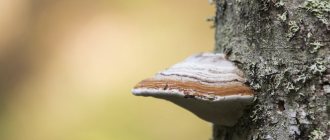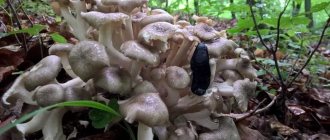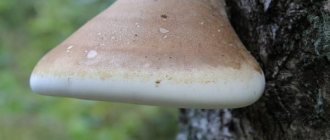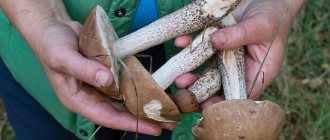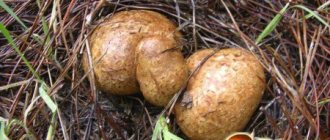Polypore is popular not only because it is a material for making tinder, which is used to make fire in the field, and not at all because of a number of healing properties. The fungus takes an active part in the process of decomposition of the wood of dead trees, which poses a huge danger to a living tree.
The polypore fungus, in particular the plum polypore, is a most dangerous parasite for trees, which humans have been fighting unsuccessfully for many years. A harmless-looking, and sometimes cute, growth in the form of a hoof or a hemisphere on a tree indicates that the tree is infected and doomed. An apple tree or other fruit tree is destined to put up with these drones on its body for the rest of its days. The death of the tree is only a matter of time.
The larger and younger the tree, the longer it will live.
The outer growth on an apple or plum tree is the tip of the iceberg, just the fruiting part of the tinder fungus. Its main part, the root system, called mycelium, is located inside the trunk.
When tinder appears, the death of the tree is only a matter of time
Distinctive features of wood mushrooms
The parasitic species are basidiomycetes. The main feature of organisms is the place of growth - wood. As they develop, they decompose the bark through special enzymes and absorb biologically active substances. Found on living or dead trees of various species. They often grow in large groups, forming several rows (plates).
It is impossible to identify a single characteristic based on its external form. There are parasitic mushrooms that are similar to traditional species (most of them have short legs and a fleshy and large cap), others do not have a clear shape.
Important! Old specimens have hard flesh and are often bitter. Sometimes they can cause digestive disorders. Due to the lack of a distinct taste, the legs are cut off when cooking.
How can you tell if a tree in the garden is infected with tinder fungus?
How to understand that a plant is infected with a parasite:
- Hollows form in the trunk.
- The bark changes color and becomes darker.
- Black stripes appear on the trunk and branches.
- The branches begin to dry out.
- If you cut a branch, you can see that the bark is peeling off and the middle begins to rot.
A tree is affected by tinder fungus.
A living tree can be saved if timely measures are taken.
TOP 5 interesting facts about tree mushrooms
Edible species that parasitize plants are used in the preparation of salads and main dishes. They are pickled and salted, eaten stewed and fried, and added to snacks and delicacies in Korean and Chinese. Heat treatment is required before use. Energy value (calorie content) – 14-25 kcal.
Interesting facts worth noting:
- Crafts made from wood mushroom. From the hard pulp of some species they make figurines, jewelry (pendants, pendants), and make original lamps and lighting fixtures.
- Ability to bear fruit on wet sawdust, straw or cellulose. This feature allows you to grow some varieties in summer cottages.
- Increases with soaking. Tree mushrooms are small in size when dried, but when placed in water they expand several times in size.
- Taste of seafood. Species growing on trees differ in taste characteristics from classic mushrooms.
- Unique chemical composition. Many species have healing properties for the body and improve mental activity. They are used as part of low-calorie diets for weight loss, in the treatment of allergies, gastritis, oncology, diabetes and other diseases.
Useful types can be purchased in pharmacies in dry form. They are also included in a number of preparations for internal use and external application. In stores they are sold in pressed form (packaging briquettes).
Important! The benefits and harms of tree mushrooms depend on the correct method of preparation and compliance with contraindications. Store them dried in a cool, dry place to prevent the formation of mold.
Parasites in the fields
Parasitic on agricultural crops:
- smut;
- ergot;
- rust mushroom.
Smut mushrooms
This group of parasitic fungi prefers cereal crops. Most often they settle on barley, wheat or oats. Sometimes found in corn fields and millet. There are a large number of varieties of smut fungi, each of them affects a specific crop. About 20 species are common in Russia. The ability to adapt to any climatic conditions greatly complicates the fight against smut. A coating similar to soot appears on the affected plants (fruits, seeds). Spores spread quickly. Smut can destroy the entire crop.
The fight against the parasite is not limited to the destruction of affected ears. The spores remain in the ground and form mycelium in new shoots. The fight against smut includes disinfection of the land, which means that for several years it is better to plant plants on the site that are not affected by the parasitic fungus of this variety. You can plant hybrid varieties of cereals that are resistant to smut.
Ergot
Ergot is a parasitic fungus that prefers wheat. Sometimes it affects other cereals. Ergot can cause harm to the human body. It causes eating disorders and poisoning. After the wheat begins to ear, the first signs of damage appear. Sweet secretions with a specific odor appear on the spikelets, attracting various insects (flies, midges, etc.). These insects carry the spores. After the sweet discharge, sclerotia appear. They are shaped like horns and are dark purple in color, sometimes with a purple tint. Their length varies from 3 to 5 cm. Healthy wheat grains do not exceed 1.5-2 cm in length. Fallen horns that have overwintered in the ground are a source of disease.
Irina Selyutina (Biologist):
Ergot is one of the most famous poisonous (toxic) mushrooms. The toxicity caused by ergot alkaloids was previously widespread in Europe, with death tolls approaching those of the plague and cholera. Clavicepsotoxicosis, or ergotism, is caused by the ability of ergot toxins to cause contractions of smooth muscles and blood vessels, as well as effects on the nervous system. It is known in two forms:
- gangrenous (“Antonov fire”);
- convulsive (“angry writhing”).
It is difficult to destroy a harmful microorganism that appears on the site. To minimize the likelihood of infection in grain fields, it is necessary to use high-quality planting material and promptly destroy weeds. It is advisable to disinfect the seeds and treat the fields with fungicides. Most often, ergot appears on neglected plots of land.
Rust mushroom
This parasite got its name due to its appearance. It prefers cereal crops, but sometimes appears on ferns and flower crops. Brown or red-brown lesions appear on plants. Depending on the type of rust fungus, and there are a huge number of them, this formation has the shape of a bowl, glass or cylinder. Sometimes it is dispersed almost all over the leaves and stems of plants, and sometimes it is not. Leaves of diseased plants change shape and turn yellow.
Rust fungi are obligate parasites. This means that their life cycle and the life cycle of the host are coordinated with each other and the parasite is not able to survive without its host. Often they require 2 different hosts for their development. In the case of grain crops, the second host is barberry. To avoid contamination of fields, these crops are not planted nearby. It is also better to use hybrid varieties resistant to the parasite, harvest and fertilize in a timely manner. Affected crops are treated with fungicides.
Similar mushrooms
Some species are difficult to distinguish from each other due to their external similarity. Sometimes mushrooms on trees look like ordinary chanterelles, champignons, and toadstools. There are species that parasitize other plants, such as ergot. The fungus attacks the ears of cereal crops.
The danger comes from the similarity of edible specimens with poisonous ones:
- Trametes is fluffy. Settles on birch and coniferous trees. May have different shades of gray;
- Piptoporus oak. It has a large fan-shaped body, a velvety surface of a light or brown shade. More common on live oaks;
- Ganoderma southern. It has no legs, a large cap of brown shades is similar to the texture of wood. Grows on lindens, poplars and oaks;
- Postia astringent. The fruiting body is white, when young it is covered with drops of liquid; the shape may vary. Prefers conifers;
- Ischnoderma resinous. As it grows, red drops appear on the cap. The surface has a bronze or reddish color. Prefers deciduous forests.
Before using collected specimens, it is recommended to ensure that they are edible. Knowledge of external features will allow you to collect healthy, safe and tasty mushrooms.
Research results
According to statistics, for every 3,000 ordinary trees, without growths, there is on average one burl tree.
Since 1959, due to the value of such wood, the Central Research Institute of Forest Genetics of the USSR Academy of Sciences began to study the biological study of burls and methods of growing them. Scientists have developed a technology for sowing and growing birch trees with burls. As a result, a huge grove was planted in the Moscow region. And since 1967, similar birch trees began to be planted in forestry enterprises in the Kirov region.
What methods of controlling tinder fungus exist?
If you find tinder fungus in your garden, this is not the time to mourn. Although it is still worth drawing certain initial conclusions. At least in order to understand the scale of what happened. Remember: if the body of a mushroom appears on the fruit tree, it means that approximately 50% of the plant is already infected with fungal enzymes and rot. What should be done in this case?
- Firstly, make every effort to ensure that other trees that grow in the vicinity of the affected plant do not become infected from it.
- Secondly, to extend the “lifespan” of a fruit tree that has been occupied by tinder fungus.
If the tree is strong and healthy, then it will last a maximum of seven more years. And then he will die anyway. However, there are methods to extend the life of such poor fellows. Let's talk about them.
Inspection and emergency machining of the barrel
At the beginning of summer, you need to begin a thorough inspection of the inhabitants of your garden. There are clear deadlines by which the plan must be implemented. They are limited to the beginning of August, since it is during this period that parasitic fungi begin to ripen spores.
Algorithm of actions when detecting tinder fungus
- We lay a fairly large and dense plastic film under the tree on which the parasite was found. It is very important that particles of everything that will be mechanically cut from the affected tree do not scatter throughout the garden and do not end up on other trees or in the ground.
- We take a sharp knife and carefully cut the parasite from the surface of the tree, capturing, along with the mushroom body, particles of bark that have already rotted or have begun to rot.
- The places that remain after removing the fungus and damaged bark must be cleaned with a knife to a healthy depth: that is, as long as you see the damaged wood, the “wound” should be cleaned. And as soon as you get to healthy tissue, the stripping process can be stopped.
Everything that fell from the trunk during the process of stripping the tree must be carefully wrapped in polyethylene and sent to the stove or grill for burning. It is better to burn the remains of the mushroom immediately, and only after that you can safely and confidently move on to the second stage - sanitization.
Sanitation
Before you begin sanitization, analyze how badly the tree is infected and where exactly the parasite is located. This should give you some ideas.
- If the trunk is infected , the fruit tree will live no more than three years. To cope with the problem, you need to use a saw to cut off the trunk of the plant almost to the root. After the trunk is eliminated, the cut must be treated with a solution prepared from 30 grams of copper sulfate and a liter of water. After processing, the cut should be allowed to dry completely. The last stage is cementing.
- If a branch is infected , take a saw and cut it down about 10 cm below the place where the parasite came out. If, at the time of cutting, you suddenly discover that there is rot inside the wood, the conclusion will be obvious: the presence of rot is a sign that the infection process has managed to go down. In such a situation, the damaged branch on which the parasite lived is cut down to the root.
Amateur gardeners recommend treating cut branches, or rather the sections remaining after cutting, with their usual garden varnish. And everything would be fine, but over time this substance loses its initially inherent consistency and density. Consequently, the disease “sealed” with var can begin to progress. To prevent this from happening, you can replace the garden varnish with an alternative remedy in the form of a microbiological preparation, the purpose of which is to combat pathogenic microflora.
- Take a liter of water.
- Add 10 grams of Fitop Flora-S to it.
- We treat the cut area, the area around this place, the trunk, as well as all “wounds” and cuts on the tree with the prepared solution, through which parasite spores can hypothetically penetrate into the wood.
- Leave the treated wood for 48 hours to dry completely.
- Spray the plant with a solution of copper sulfate.
Trees that have undergone treatment should be carefully inspected twice a year. The described measures will allow harvesting from diseased plants for about another ten years. Or maybe longer.
Parasites on shrubs and vegetables
Late blight is caused by fungal spores
Vegetable crops and shrubs are affected by late blight, scab, and rot. All these diseases are caused by fungal spores.
- Late blight: Late blight fungus affects potatoes, tomatoes, cucumbers and peppers, i.e. representatives of the Solanaceae family. First, the foliage wilts. Then dark brown spots appear on the leaves and fruits.
- Powdery mildew: the disease is caused by several types of fungi (spheroteca, uncinula) and most often affects gooseberries. A white coating appears on the fruits. Plants can be damaged in spring and autumn.
- Fruit tree scab: Venturia fungus forms velvety olive-colored spots of small diameter on leaves and fruits.
- Gray mold: Caused by a fungus called botrytis. The fruits of the affected plant are covered first with white and then with black-brown bloom. Rot forms under the coating.
Any fungal disease develops quickly, which is why treatment begins after the first signs of the disease appear. All parts of the plant affected by the fungus are destroyed. Then the plants are treated with special preparations in strict accordance with the instructions supplied with them. After harvesting, the land is disinfected. A preventive measure is to observe crop rotation. It is convenient to monitor crop rotation using a table, the rows of which are the name of the crop being grown, and the columns are the years. Crop rotation (multifield) can be 3, 4, 5 fields, etc.
It cannot be said that any of the listed parasites are more or less dangerous. You have to fight with any of them, because... they ultimately lead to the death of the host organism.
